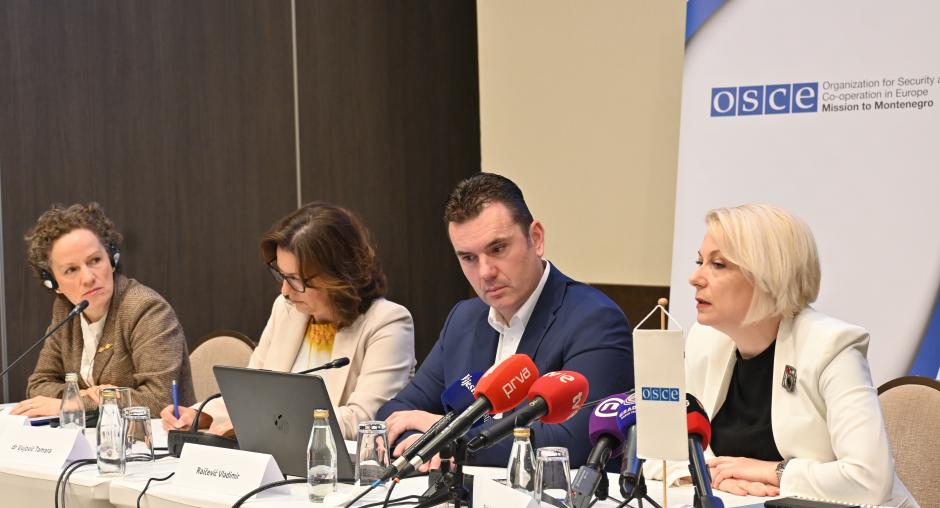Media literacy among citizens of Montenegro can improve, education is key, shows OSCE-supported survey

There is nearly unanimous consensus among citizens of Montenegro (92 per cent) that media literacy is of great importance. However, 62 per cent of respondents rate the media literacy of Montenegrin citizens as poor, and understanding the internet and social networks appear to be at an insufficient level. Education is widely recognized as a key measure to improve media literacy.
These are some of the key findings of public opinion research “Media Literacy in Montenegro”, commissioned by the OSCE Mission to Montenegro and conducted by IPSOS Agency, a joint activity with the Ministry of Culture and Media and the Agency for Electronic Media (AEM).1,003 citizens aged between 16 and 75 were interviewed in the research during the months of June and July 2023.
Vladimir Raičević from IPSOS said that, when specifically asked how they would verify the accuracy of a contradictory information on the internet, only 27 per cent of respondents would analyze the characteristics of the websites where they found the information, 26 per cent would seek the opinion of experts in the relevant field.
“The research also recognized the need to cultivate media literacy among citizens, particularly among both older and younger age groups, each facing distinct challenges in assessing media information. Older adults and elders (aged 30-75) acknowledge that the youngest are most susceptible to accepting false information, primarily due to their limited life experience and unfamiliarity with the political landscape. On the other hand, younger individuals (aged 16-25) see elders (aged 65+) as a vulnerable group due to their deficiency in digital skills and lack of critical reflection on news/greater trust in the media,” said Raičević.
Television is still both the most used “traditional” medium and generally the source of information about national and international events – 74 per cent of respondents say that they use TV as a source of information at least several times a week, while 60 per cent do this every day. Online media, such as news web portals, internet dailies, media agencies’ applications and news blogs, are the second most common source of news – 68 per cent of respondents use them to get informed several times a week or more frequently, and social networks are at a similar level. Responsibility for disseminating unverified content is predominantly attributed to online media.
Head of the OSCE Mission, Dominique Waag, said that this survey provides a baseline for the Mission, the Ministry and the Agency, as well as interested stakeholders, for instance in the sector of education, for the level of media literacy present in Montenegro. “It will help shape media literacy activities and initiatives in the future. Research shows two elements: first, investing in media literacy and education in schools, enabling students to understand how to decipher media messages, is crucial, as the only sustainable, long-term answer to challenges of the digital age. Second element refers to the importance of the role of professional journalists. Media can be an antidote to false and misleading information, providing citizen with fact-checked information, mitigating the impact of hate speech and offering pluralistic points of view. Professional, ethical and investigative journalists, serving a public interest, have to be praised,” said Ambassador Waag.
Minister of Culture and Media Tamara Vujović said that in today’s digital era, we are witnessing that the quantity of information and offered media content, which are more available than ever, are not necessarily followed by the quality. “On the contrary, we often encounter malignant phenomena such as disinformation, various forms of manipulation and sensationalism, fake news... Therefore, it is clear how important media literacy is in suppressing the aforementioned phenomena. Unfortunately, we still cannot boast of great results when it comes to the state of media literacy in Montenegro. According to the research of the NGO ‘Institute for Open Society’ from Sofia, which was used for the purposes of drafting the 2023-2027 Media Strategy in 2021, Montenegro found itself at the very bottom of the scale when it comes to media literacy. The Ministry of Culture and Media has taken a number of steps to improve the state of media literacy among our citizens,” said Minister Vujović and recalled that the first Media Strategy with its 2023-2024 Action Plan has been recently adopted, emphasizing the need for strengthening media literacy among citizens. “The Ministry is determined in its approach to support the development of media literacy among citizens. Media literacy is not only a challenge for our government or institutions. It is a challenge for every individual in our society. I invite all citizens to take an active role in acquiring media literacy through education, research, asking questions and to critically analyze the information we consume. That’s the only way we can become resistant to manipulations, half-information and misinformation,” concluded the minister.
The Director of the Agency for Electronic Media Sunčica Bakić said that AEM has recognized the importance of media literacy for the development of a democratic society quite early in its work. “The support of the OSCE Mission to Montenegro has resulted in a significant improvement of the strategy and activities being implemented. Our co-operation and activities have aimed to develop media literacy among three target groups: media professionals, parents and educators, and children. In addition to these three target groups, starting this year, we are expanding the scope of joint co-operation and launching activities to improve media literacy for adults,” said Bakić, adding that efforts to raise the level of media literacy cannot be observed in the short term, but result remain to be seen in the future.
